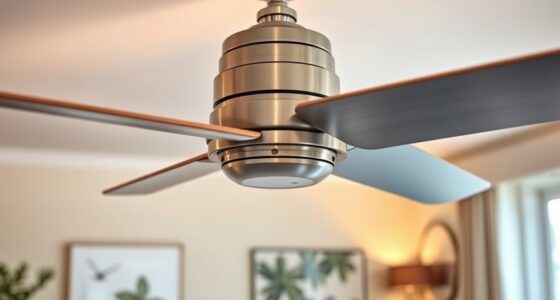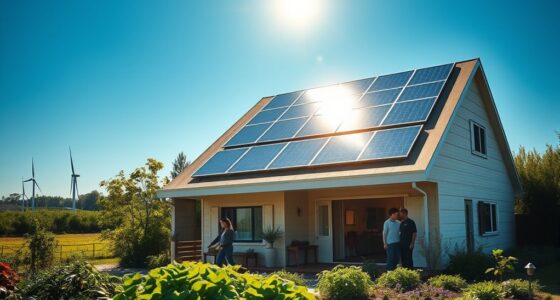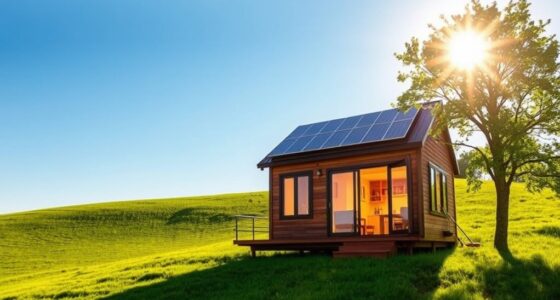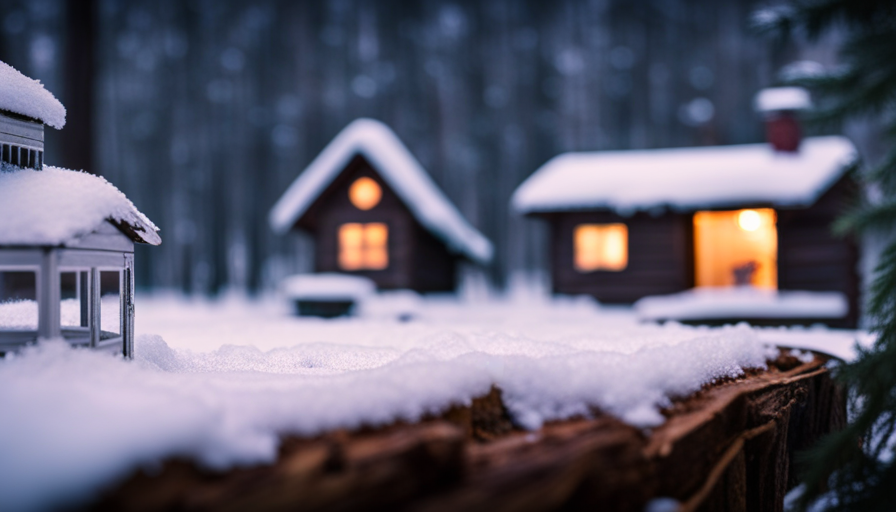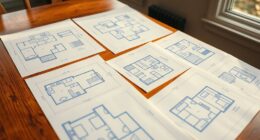Air leaks tend to cause more ongoing energy loss and higher costs than insulation gaps because they allow conditioned air to escape continuously. Sealing leaks can quickly reduce your bills and improve comfort, often offering better cost-effectiveness than just adding insulation. While insulation slows heat transfer, it doesn’t stop air movement. To save money long-term, addressing leaks is essential. Continue exploring so you can learn how to prioritize and save even more.
Key Takeaways
- Air leaks typically cause more energy loss than insulation gaps, leading to higher costs.
- Sealing air leaks can reduce energy bills by 10-20%, often more cost-effective than insulation upgrades.
- Small leaks (1 CFM50) can equal heat loss from large insulation gaps, making leaks more expensive long-term.
- Proper sealing prevents moisture and pests, avoiding costly repairs associated with leaks.
- Insulation slows heat transfer but does not stop air movement, so leaks generally cost more if unaddressed.
Understanding the Cost of Air Leakage
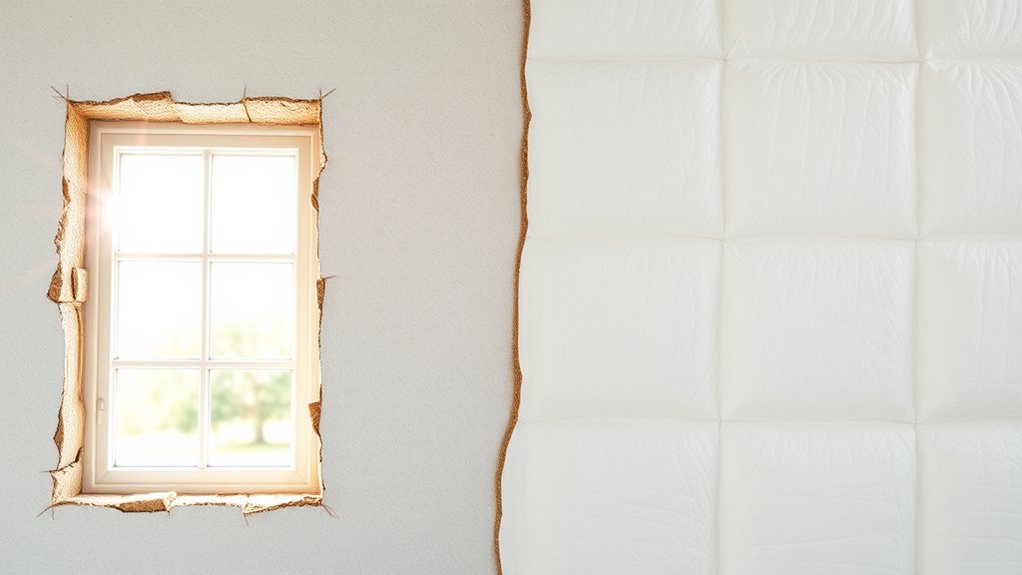
Understanding the cost of air leakage is essential for making informed decisions about home energy efficiency. You should know that sealing your home’s envelope typically costs around $730, while duct sealing averages about $789. Increasing your investment in air sealing from $0.34 to $0.68 per square foot can triple your reductions in leaks, making the effort more effective. Duct sealing is often twice as efficient as envelope sealing at similar costs, so it might be a better investment. Keep in mind that the average energy cost caused by air leakage can reach $248 per heating season, which varies based on your location and home size. Older and smaller homes tend to leak more, leading to higher energy bills. Investing in airtightness can yield significant savings over time. Additionally, the effectiveness of sealing depends heavily on the air leakage pathways present within your home, highlighting the importance of proper assessment and targeted sealing efforts.
The Financial Impact of Insulation Gaps
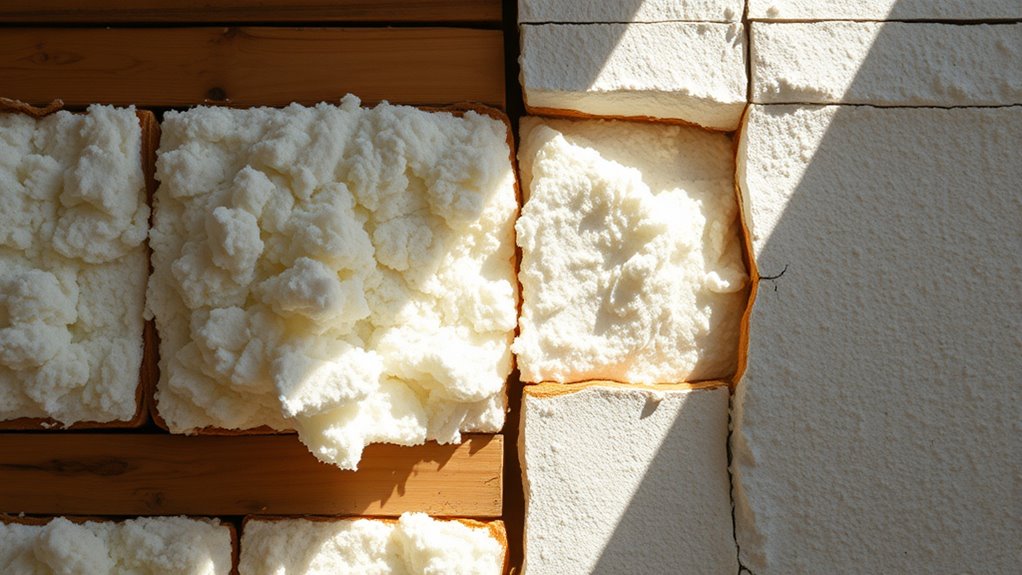
Insulation gaps can substantially drain your home’s energy budget, causing losses of up to 30% during the colder months. This inefficiency forces your heating system to work harder, increasing your utility bills and wasting roughly $200 to $400 annually of your $2,000 energy budget. Here are key impacts:
Insulation gaps can waste up to 30% of your home’s energy, increasing bills and HVAC wear.
- Higher energy costs due to increased heating demands.
- Faster wear and tear on HVAC systems, raising maintenance expenses.
- Uneven indoor temperatures, prompting higher thermostat settings and further costs. Proper insulation not only improves energy efficiency but also enhances overall comfort within your home.
Insulation gaps can also lead to increased moisture intrusion and mold growth if not properly addressed, further compromising your home’s health and safety. These issues not only inflate your monthly bills but also shorten your HVAC system’s lifespan, leading to costly replacements. Upgrading insulation can significantly reduce these expenses, making it a smart financial move that pays off quickly.
Comparing Energy Loss: Air Leakage Versus Insulation Gaps
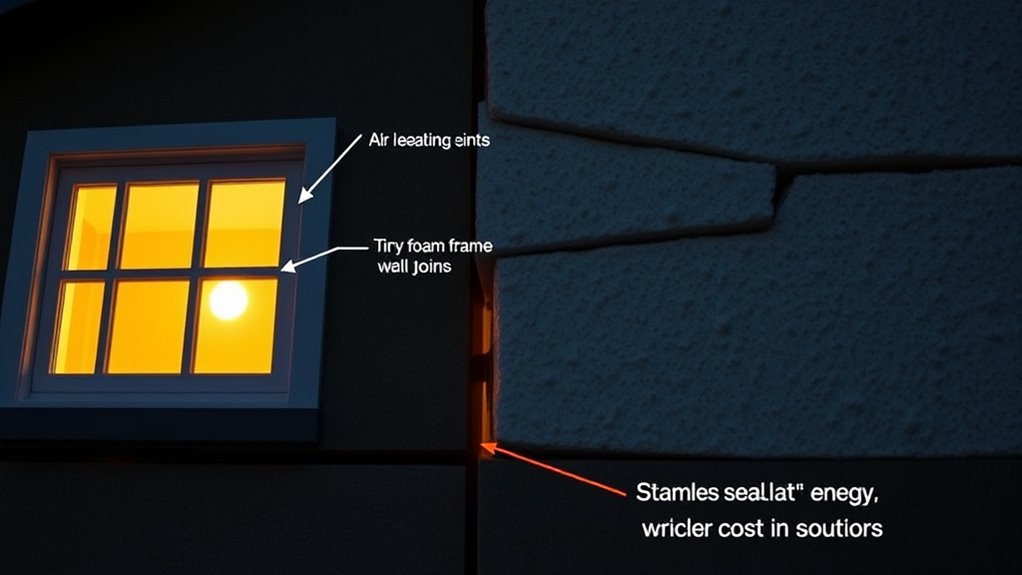
Air leakage often causes more energy loss than insulation gaps because even small air leaks allow heated or cooled air to escape continuously, forcing your HVAC system to work harder. Studies show air leaks account for 25% to 40% of total energy loss, making them a significant contributor to higher energy bills. The heat loss from just one CFM50 air leak is equivalent to an entire square foot of R-20 insulation, highlighting how small leaks can be as damaging as large uninsulated areas. While insulation gaps slow heat transfer, they don’t prevent air movement, leading to subtle but persistent heat loss. Unchecked air leaks undermine insulation’s effectiveness, increasing energy consumption and reducing indoor comfort. Prioritizing air sealing is essential for minimizing overall energy loss.
Cost-Effectiveness of Sealing and Insulation Repairs
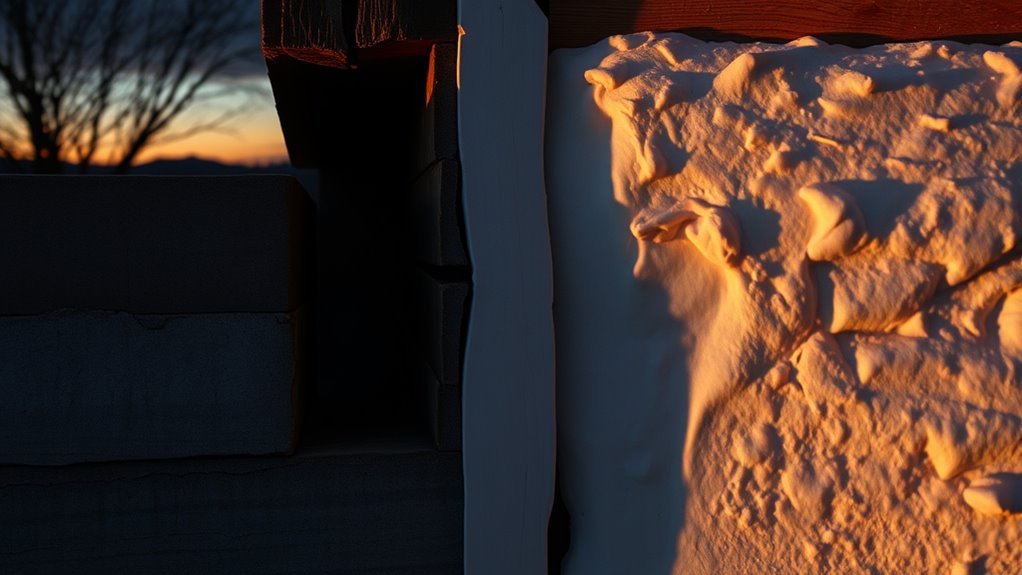
Sealing your leaks offers a high return on investment because it costs less and quickly improves energy efficiency. In contrast, insulation repairs can be more variable in cost and effectiveness, depending on the materials and extent of installation. By focusing on sealing first, you can often achieve significant savings before considering more extensive insulation upgrades. Sealing can reduce energy waste more immediately and is typically less expensive than comprehensive insulation projects, making it a more cost-effective initial step.
Sealing: High ROI Potential
Investing in sealing and insulation repairs offers some of the highest returns on home energy improvements. Proper sealing can reduce leaks by up to 27%, leading to average savings of 20% on heating and cooling costs. The cost for envelope air sealing is around $730, with duct sealing slightly higher at $789, both providing predictable, low-cost options. To maximize ROI, consider:
- Tripling leakage reduction with moderate sealing investments ($0.34 to $0.68/ft²).
- Achieving a payback period of just 4 months with foam sealants.
- Reaching ROI levels up to 4400% over seven years, surpassing other measures.
- Energy efficiency improvements can significantly lower utility bills and enhance comfort, making sealing a highly effective strategy for energy savings.
Sealing is especially effective in leaky or colder climates, offering quick, significant savings while improving HVAC efficiency and reducing environmental impact.
Insulation: Variable Cost Efficiency
Have you ever wondered how cost-effective insulation upgrades really are? The answer depends on factors like material choice, area size, and current R-value. For example, blown-in insulation averages around $2,900, while fiberglass costs about $0.90 to $1.50 per square foot. Insulation effectiveness decreases over time, with a recommended renewal every 15–20 years, but beyond R-20 or R-21, adding more offers diminishing returns. Increasing insulation thickness raises material costs but doesn’t always justify the energy savings. Structural limits may prevent deep upgrades, and regional costs vary. To maximize value, weigh the upfront costs against potential long-term energy savings. Remember, insulation’s economic efficiency depends on balancing initial investment with ongoing comfort and utility bill reductions. Proper installation is crucial to ensure that the insulation performs as intended and delivers optimal cost savings over its lifespan. Additionally, understanding the key components of effective insulation can help in making informed decisions.
Hidden Expenses and Long-Term Savings
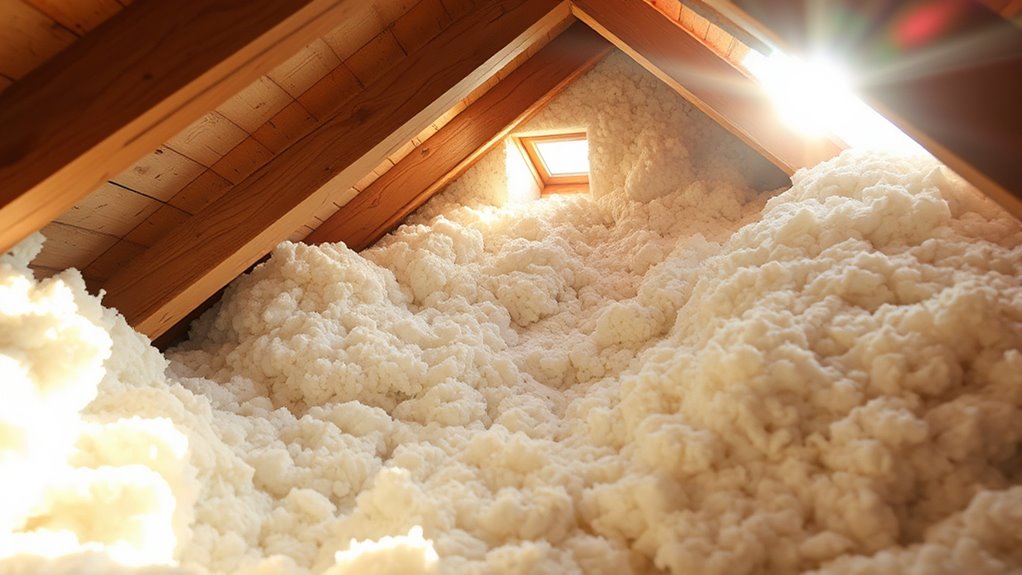
Ignoring air leaks and insulation gaps can lead to hidden energy costs that add up over time, raising your monthly bills. Investing in proper sealing and insulation saves you money by reducing ongoing expenses and preventing costly repairs. Over the long run, these upgrades pay off through improved comfort, lower maintenance needs, and energy efficiency. Proper installation and sealing are essential for maximizing these benefits and ensuring your home remains energy-efficient.
Hidden Energy Costs
Hidden energy costs from air leakage and insulation gaps can silently drain your utility bills over time, making your home much more expensive to operate than it needs to be. These gaps cause ongoing heat loss or gain, forcing your HVAC system to work harder and consume more energy. Proper sealing can reduce energy bills by 10-20%, lowering your monthly expenses. Addressing these issues can lead to significant savings:
- Proper sealing can reduce energy bills by 10-20%, lowering your monthly expenses.
- Insulation gaps allow heat to escape or enter, increasing heating costs and reducing comfort.
- Combining air sealing and insulation can cut overall energy consumption by 15% or more, especially in extreme climates.
Ignoring these hidden costs means paying higher utility bills year-round and risking additional expenses from moisture, pests, and equipment wear. Effective sealing techniques can also help prevent moisture buildup and pest entry, prolonging the lifespan of your home’s structure. Fixing these issues offers quick financial benefits and prevents long-term waste.
Long-Term Savings Benefits
Sealing air leaks and adding insulation can lead to substantial long-term savings on your energy bills. When you reduce air leakage, your home loses less heat in winter and gains less in summer, cutting your heating and cooling costs by an average of 15%. Proper attic sealing before insulation maximizes these savings by preventing heat transfer through gaps and cracks. Combining air sealing with insulation often offers a better return on investment than insulation alone, lowering your overall energy expenses. High-quality sealing materials, like spray foam, maintain their performance over time, reducing future repair costs. Additionally, reducing moisture infiltration prevents mold and structural damage, extending your home’s lifespan. Effective air sealing also improves indoor comfort by minimizing drafts and temperature fluctuations. Incorporating biodiversity-friendly materials and practices in your home’s insulation can support healthier indoor environments and reduce exposure to potentially harmful chemicals. These measures not only save you money now but also protect your home’s long-term value and durability.
Maintenance and Repairs
Regular maintenance of your home’s air sealing and insulation systems is essential to prevent costly repairs down the line. Air leaks can cause moisture infiltration, warping frames, and escalating minor issues into major repairs. Addressing leaks early with caulking or weatherstripping saves money, while delayed fixes may require complete window replacements. Understanding air leaks is crucial, as small gaps can develop over time due to materials shrinking, expanding, or shifting. Consider these points: 1. Frequent inspections are needed for air leaks, which degrade weatherstripping and increase maintenance costs. 2. Unseen damage from leaks can lead to structural issues, resulting in expensive repairs. 3. Detection costs for air leaks often involve professional tools like thermal imaging, adding to expenses, unlike insulation gaps which are easier to identify. Proper maintenance reduces unexpected costs and prolongs your home’s integrity.
Making Informed Decisions for Home Efficiency

To make informed decisions for your home’s energy efficiency, it’s essential to understand the differences between air leakage and insulation gaps. Air leakage involves uncontrolled air flow through cracks and gaps, wasting conditioned air and increasing heating and cooling costs. Sealing leaks can save you 11–15% on energy bills and often costs around $1,450 for a 1,500 sq.ft. home, with attic sealing being a priority. Insulation gaps reduce thermal resistance, allowing heat transfer that raises energy use and decreases comfort. Fixing these gaps improves insulation performance and can be cost-effective depending on materials and access. Typically, sealing air leaks offers quicker results and better cost savings initially. To maximize efficiency, focus on sealing leaks first, then upgrade or repair insulation gaps for long-term comfort and savings. Understanding pinball machine weight is also crucial when considering home installation or transport.
Frequently Asked Questions
How Do Air Leakage and Insulation Gaps Affect Indoor Air Quality?
You should know that both air leakage and insulation gaps directly impact your indoor air quality. When air leaks occur, pollutants, dust, and moisture can enter, causing health issues and mold growth. Insulation gaps allow outdoor contaminants to seep in and trap moisture inside walls, worsening air quality. Sealing leaks and installing proper insulation are essential steps to guarantee cleaner, healthier indoor air and prevent long-term problems.
Can Sealing Air Leaks Cause Moisture Problems or Mold Growth?
Sealing air leaks can help prevent moisture problems and mold growth if you do it correctly. When you seal leaks, you stop humid indoor air from entering cooler attic spaces, reducing condensation and mold risk. However, if you over-seal without proper ventilation, moisture can get trapped inside, increasing the chance of mold. So, balance sealing with good ventilation and moisture control to keep your home healthy.
What Are the Best Tools to Detect Hidden Air Leaks and Insulation Gaps?
Did you know that up to 30% of a building’s energy loss can come from hidden air leaks and insulation gaps? To detect them, thermal imaging cameras are your best bet—they reveal temperature differences indicating leaks or missing insulation. Smoke pencils and synthetic smoke show airflow paths, while ultrasonic detectors find even tiny leaks. Pressure tests and blower door tests provide detailed evaluations, ensuring you locate and seal all hidden issues effectively.
How Does Climate Influence the Cost-Effectiveness of Sealing Versus Insulation?
Climate plays a key role in how you should prioritize sealing and insulation. In colder areas, sealing gaps and adding insulation save more on heating costs. In warmer regions, preventing hot air infiltration reduces cooling expenses. You’ll find that investing in insulation is more cost-effective in severe climates, while sealing gaps offers better short-term savings in milder climates. Tailoring your approach to your climate guarantees the best energy savings and comfort.
Are There Government Rebates or Incentives for Upgrading Home Sealing and Insulation?
Think of government incentives as a hidden treasure map guiding you to savings. You can claim a 30% federal tax credit on qualifying insulation and air sealing products, up to $1,200 annually. Plus, utility rebates, like Puget Sound Energy’s up to $2,300, can boost your budget even more. Just keep receipts and certifications handy, and you’ll access these perks to make your home more efficient without breaking the bank.
Conclusion
When it comes to saving on energy costs, remember that a stitch in time saves nine. Addressing air leakage and insulation gaps early can prevent small issues from turning into costly repairs down the line. By sealing leaks and insulating properly, you’re not just plugging holes—you’re investing in your home’s efficiency and your wallet’s health. Don’t let hidden expenses sneak up on you; taking action now keeps everything running smoothly in the long run.
I’m Theodore, and I love tiny houses. In fact, I’m the author of Tiny House 43, a book about tiny houses that are also tree houses. I think they’re magical places where imaginations can run wild and adventures are just waiting to happen.
While tree houses are often associated with childhood, they can be the perfect adult retreat. They offer a cozy space to relax and unwind, surrounded by nature. And since they’re typically built on stilts or raised platforms, they offer stunning views that traditional homes simply can’t match.
If you’re looking for a unique and romantic getaway, a tree house tiny house might just be the perfect option.



